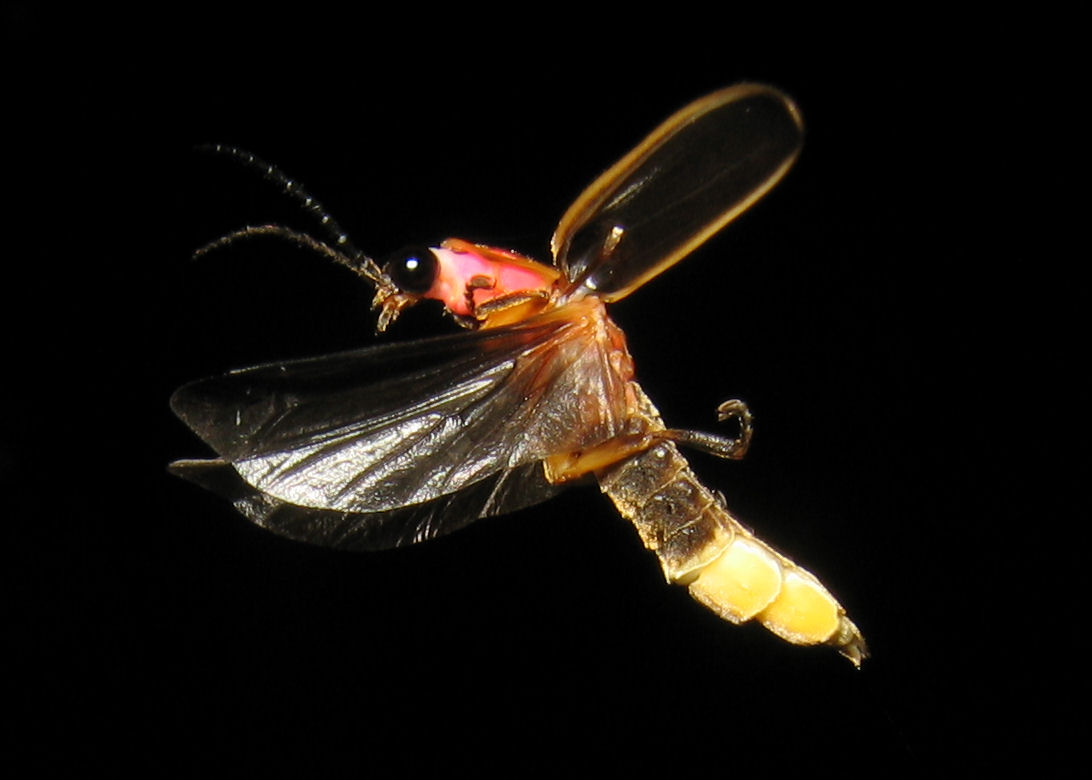The lightning bugs are out, lending their own special magic to a June evening. We used to chase them and catch them in a jar when we were kids. We wondered how they could light up like that, and hoped to watch them do it in the jar. I’m afraid our little captives didn’t fare very well, and now it makes more sense just to revel in the symphony of flashes. But what exactly are they? Bugs? Flies? And what are they doing out there?
Lightning bugs are actually beetles. They belong to the Lampyridae family, from the Greek Lampein, meaning to shine. They create light through a chemical reaction that involves a pigment called luciferin, an enzyme called luciferase, a chemical compound called adenosine triphosphate (ATP), and oxygen. It turns out that this is the most efficient way to produce light ever. Nearly 100% of the energy from the reaction ends up as light.
Lightning bugs aren’t the only critters that make light, but they’re the only ones on Owl Acres. There are over 170 species of lightning bugs in the United States, mostly in the east and south. In Iowa, and thus most likely on Owl Acres, the ones we’re seeing flashing their love calls of an evening are winged beetles about three-quarters of an inch long. Their thorax is cream or red with black markings, and their wings are gray-black with darker stripes down the middle and on the edges. They carry their light-emitting organs on the underside of the abdomen. Beetles are insects with the characteristics of all insects—three pairs of jointed legs; a head, thorax and abdomen body plan; an exoskeleton; a single pair of antennae; and two compound eyes. In addition, as beetles, their forewings have been modified to form wing cases, (called elytra) which give them a shell-like appearance and protect their delicate hindwings. They fly using only their hind wings.
Like all beetles, lightning bugs have a four-stage life cycle. The eggs are laid in mid-summer and hatch by late summer. The larvae, which are about three-quarters of an inch long, look like six-legged worms that are rounded and creamy-white on the underside, and flattened and brown on top. They spend their time eating small insects, snails and slugs. The larvae already have their light-emitting organs and are sometimes called glow worms. They spend the winter in moist places like under tree bark and debris. Come spring, they pupate and emerge as adults in early summer ready to mate.
It’s the mating that we notice in June. Where many insects use pheromones or audio calls to find and attract mates, lightning bugs use light. Males and females recognize patterns of light specific to their own species. In some species, the males fly about flashing their love calls while the females sit in the grass and evaluate them. When they see one they like, they’ll flash back. Then the male zeros in on that female and they mate.
Some species of females also have been known to mimic the flashes of another species to lure males of that species to their death as tasty morsels for the females.
The mechanism that lightning bugs use to create light has led to serious study in the fields of science and medicine. Scientists have found ways to conduct noninvasive imaging on live subjects. For instance, they can tag a tumor and then track its growth, or study the brains of rats while they’re alive.
This year we have seen very few lightning bugs on Owl Acres. Reasons are probably related to habitat loss and pesticide applications in the surrounding fields. Light pollution is also blamed because it confuses the mating rituals. Climate change is right up there, too. Many North American species are currently endangered due to these factors.
Photo by Terry Priest Alt text: Stop motion photo of a flying lightning bug. Elytra (modified forewings) carried high and forward to clear space for the hindwings to work. Insect is aligned 45 degrees from vertical. Black compound eyes forward and light organ at tip of abdomen.
